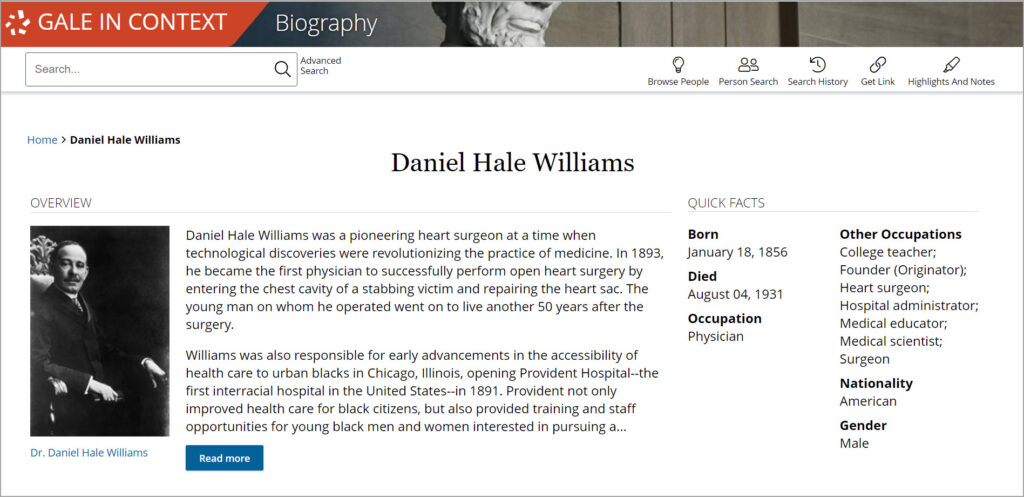| By Gale Staff |
Educators understand the value of sharing role models with their students. Integrating inspirational stories into lesson planning can increase student engagement and may even spark curiosity in a field that students haven’t considered before. First, however, students must have a chance to see themselves within these narratives. Too often, the accomplishments of racial minorities aren’t featured prominently in the curriculum. As a teacher, you have an opportunity to diversify the key figures about whom your students learn, embracing the stories of those who don’t often receive the attention they deserve in traditional textbooks.
Daniel Hale Williams is one such figure. In 1893, Williams, an African American surgeon, successfully performed open heart surgery for the first time in history. His patient, James Cornish, had suffered a stab wound to the chest. Using relatively primitive anesthesia, Williams cut through the patient’s ribs to expose the injured heart. While the heart muscle continued beating, Williams deftly sutured the lethal wound. Less than two months later, Cornish walked out of the hospital and lived for several decades more.
Using Gale In Context: Biography or Gale In Context: Science, high school students can find portals dedicated to Daniel Hale Williams’ story and accomplishments. Moreover, these databases contain thousands more historical and contemporary figures, allowing users to expand and diversify their learning. Content is expertly organized, and you can easily search for influential individuals by occupation, ethnicity, and gender. Students can effortlessly filter results and discover role models they identify with.
Get an inside look at the portals >> Gale In Context: Biography and Gale In Context: Science.

Share His Story
Daniel Hale Williams’ path to becoming an innovator in the medical field was not an easy one. Born in 1856, he was just a child when the U.S. Civil War began. Williams’ family was biracial, with ties to the Black, White, and Native American communities. Despite the societal limitations they faced, the Williams family fought for equal rights and educational opportunities for their son. In his early 20s, Williams apprenticed for a local surgeon named Dr. Henry Palmer. He then enrolled in Chicago Medical School, where he learned about the discoveries of Louis Pasteur and Joseph Lister. Williams was inspired by and unafraid to employ the latest scientific theories regarding infection prevention. This out-of-the-box spirit undoubtedly led to his leading-edge medical feats.
Highlight His Accomplishments
Despite humble beginnings, Daniel Hale Williams became one of the most famous physicians in the world for successfully completing the first-ever open heart surgery. Astonishingly, there are still many other accolades in his biography. In the 19th century, Black physicians weren’t often accepted in the field of medicine. Furthermore, Black patients struggled to find adequate health care. Williams thus established an interracial hospital—the Provident Hospital and Training School Association. Provident Hospital helped inspire and train other aspiring Black medical professionals, ultimately improving trust in the medical system and the quality of healthcare among the Black community.
Discuss Historical Context and Modern-Day Consequences
Educators might want to offer some historical context to Williams’ story, particularly given the barriers that people of color faced within the STEM community. In the late 19th century and early 20th century, the medical field was evolving but inconsistent. Most doctors didn’t actually attend a formal medical school program. They simply learned the field through apprenticeships. Unsurprisingly, the average life expectancy at the turn of the 20th century was less than 50 years old. Then, in 1908, an educator named Abraham Flexner sought to standardize the American healthcare system and reduce the number of underperforming hospitals.
The Flexner Report led to the closure of more than half of the country’s medical schools—including most of the few institutions dedicated to Black education. While Flexner ultimately sought to improve American healthcare, his recommendations also led to long-term consequences for the Black community. Over a century later, many medical experts agree that the Flexner Report created ripple effects that negatively impacted African American access to healthcare and are partially responsible for the higher mortality rates that Black Americans face today.
Introduce Leading African Americans in Medicine
Daniel Hale Williams’ Provident Hospital helped train and gave opportunities to hopeful and determined Black physicians. Some who worked at Provident Hospital became medical pioneers in their own right. W. Warrick Cardoza, born in 1905, attended medical school at Ohio State University. Following his education, he pursued a residency in pediatrics at William’s Provident Hospital. Cardoza later became a leader in sickle cell anemia research, a genetic disease that almost exclusively affects Black people.
The list of Provident Hospital trainees also includes Carl Glennis Roberts. Born in 1886, Roberts went on to attend the Chicago College of Medicine and Surgery. Throughout most of his professional career, he was affiliated with Provident Hospital, even serving as the institution’s Chairman of the Department of Gynecology. He took on a number of leadership roles and even organized the first American Medical Association (AMA) approved surgical training program for Black physicians. He also helped convince the AMA to remove the “colored” classification from the organization’s directory of physicians. While serving as a figurehead in the medical community, Roberts fought for racial equality within the medical field.
High school teachers have a chance to show students that leaders, pioneers, and innovators need not look the same. In fact, the modern-day medical field recognizes that it needs to encourage physician diversity, yet Black students and other racial minorities lack mentorship and role models in the medical field. The shortage of Black physicians negatively affects public health. Patients prefer to see a doctor who resembles them and might better understand their unique medical concerns. Introducing students to Black role models in science and medicine is a small, albeit significant step toward addressing these disparities.
Eager to bring a new, diverse group of figures into your lesson plans? Encourage your school to subscribe to Gale In Context: Biography and Gale In Context: Science.

